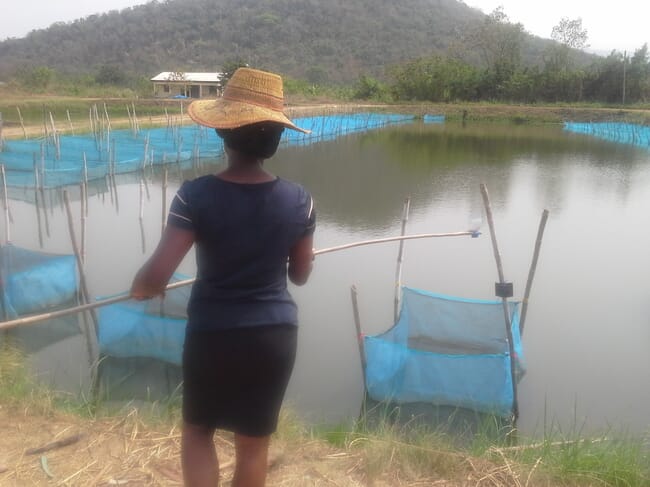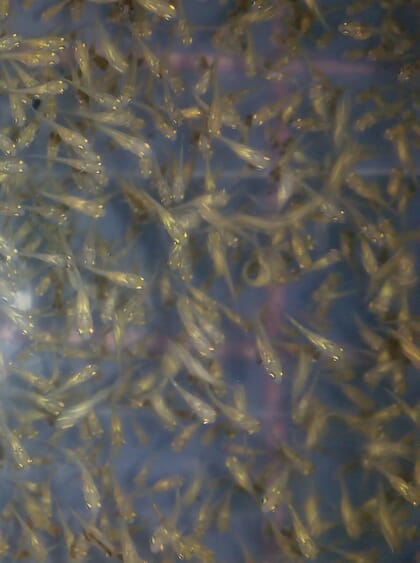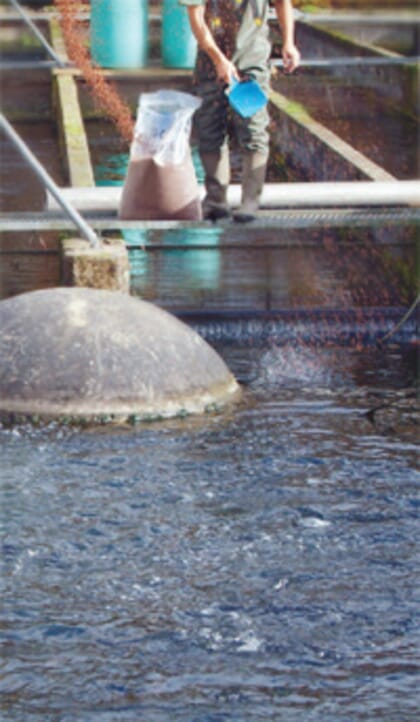Background
Tilapia aquaculture has grown dramatically in the past 20 years. More than 90 countries in the tropics and subtropics produce tilapia species and they remain popular products among consumers. Tilapia farming is viewed as a strategic asset since it provides both lucrative employment and an affordable and protein-rich food item. The sector is also a critical source of export revenue for many lower-income countries.

© ARDEC
Despite the positives, the sector faces significant challenges from disease. Multiple infectious agents target tilapines and viral infections are a major setback for production. Intensive aquaculture has made tilapia more prone to disease-causing microorganisms – high stocking densities and varying levels of water quality can expose tilapia to stress and weaken their immune systems.
The most well-known virus to target tilapines is tilapia lake virus. Since its discovery in 2014, the disease has been widely researched and reported on. However, it isn’t the only threat to tilapia farms. Other viral infections cause similar damages and losses but haven’t received the same attention from researchers and industry members. Strategies to monitor and control disease outbreaks have been slow to materialise as well – indicating an enduring challenge for the industry’s future.
It isn’t tilapia lake virus – but it might be…
Aquabirnavirus infection
Aquabirnavirus can be found worldwide and causes infections in both freshwater and marine fish. The strain that infects tilapia species causes infectious pancreatic necrosis (IPVN). Researchers exploring IPVN infections report that it can have a 25 percent mortality rate.
However, current literature doesn’t list the transmission route of the virus – there is evidence that it can be spread both horizontally and vertically and that sub-clinical infections can spread to fertilised eggs, but these findings were reported in pilot studies.
Additionally, researchers aren’t able to list precise symptoms – outbreaks of IPVN have occurred concurrently with Streptococcus infections or have presented as a sub-clinical disorder.

© ARDEC
Betanodavirus infection
Betanodavirus causes viral nervous necrosis (VNN), a disease that targets the central nervous system in tilapines. In a 2011 outbreak in Thailand, VNN had a mortality rate between 90-100 percent. Analysis from other outbreaks has shown that the virus can infect larvae, fry and fully developed tilapia.
Larvae that tested positive for VNN had lesions on the organs of their central nervous systems (cerebrum, spinal cord, olfactory bulb and retinal tissue). Infected fish were lethargic, swam erratically and spent time floating at the top of the tank. The fish also became anorexic and developed dark pigmentation. Tissue analysis showed significant damage in the eyes, spinal cord and brain. The tilapia also showed neuronal necrosis. During other outbreaks of VNN, tilapia displayed neurological disorders (loss of balance and corkscrew-like swimming) before dying.
Researchers caution that sub-clinical infections are possible and that tilapia who have survived VNN outbreaks could potentially carry the disease.

Herpesvirus infection
The most common herpesvirus infections in tilapines are tilapia larvae encephalitis (TELV). Symptoms usually include whirling swimming patterns and dark pigmentation over the fins and skin. Further examination of infected larvae showed herpes virions in portions of the brain tissue and extensive damage to the central nervous system. TELV causes high mortalities, in some cases mortality rates were between 92 and 98 percent.Researchers concluded that sexually mature males and females could carry and transmit the virus to their offspring. Other research projects demonstrated that TELV can be spread between different species of fish after cohabitation.
Iridovirus infections
Bohle virus infection (Ranavirus)
Bohle virus (BVI) was first detected in a lab in Australia. In that study, infected tilapia had a 100 percent mortality rate. Infected fish exhibited corkscrew-like swimming (spinning) and had significant lesions on organ tissues – especially the kidneys and spleen. BVI can be transmitted laterally (from infected fish to naïve populations) via feeding.
Currently, there isn’t a BVI molecular detection method for tilapia species.
Megalocytivirus
This DNA virus causes infectious spleen kidney necrosis (ISKNV) and has been reported in Nile tilapia and red hybrid tilapia. Other iterations of the virus infect both freshwater and marine species.
ISKNV was first observed on a tilapia farm in the United States in 2012. Infected fish were lethargic and carried excess fluid in the abdominal cavity. Further examination showed megalocytes (large, abnormally shaped red blood cells that usually indicate anaemia) in the gills, kidney, spleen, liver and intestinal cells. The facility reported a 50-75 percent mortality rate over a two-month period.
A study in Thailand showed that ISKNV could be transmitted vertically from sub-clinical broodstock, with females being more adversely affected than males. Megalocytivirus infections often occur concurrently with other disease outbreaks in farmed tilapia.
Iridoviral-like infection
This infection was first reported on a Canadian fish farm in 1998. Diseased fish were lethargic, and either swam slowly or rested at the bottom of the tank. The fish exhibited discolouration around the gills and had redness under the jaw area. Infected fish also had bulging eyes – occasionally popping out of the sockets (exophthalmia).
Autopsied tilapia had multiple protein-rich fluid deposits in their abdominal cavities and their internal organs were pale. Researchers observed some petechial haemorrhaging in the liver and identified scattered necrotic cells and cell debris.
Researcher’s couldn’t uncover extensive information on the virus. The molecule that causes symptoms in tilapia hasn’t been fully isolated – researchers were only able to identify Iridoviridae family virions.
Staying ahead of the curve
The researchers recommend that producers who wish to increase their chances of avoiding viral infections should use using specific pathogen-free tilapia for breeding programmes. Similarly, they advise that investing in advanced molecular diagnostics will allow farmers to determine if individuals are virus-free at different points in the tilapia life cycle. They also recommend implementing a vaccination programme as part of a long-term development strategy.

However, they warn it will be difficult to fully implement these solutions – especially vaccination. Many of the viral diseases the researchers’ reviewed infect larvae and fingerlings that don’t have fully developed immune systems. This would make vaccination ineffective. There could also be an economic barrier when implementing a vaccine protocol. Many tilapia farms are in lower income countries and have tight profit margins. Some farmers lack the capital to invest in vaccines.
The researchers also caution that viruses aren’t the only challenge facing tilapia producers. Parasites and bacteria can infect tilapine species and cause significant losses.
To respond to these challenges, the authors recommend expanding research into genetic technologies. Gene editing breakthroughs could allow researchers to enhance certain genetic traits or create disease-resistant broodstock.
The case for widespread disease surveillance
The researchers also recommend initiating virus surveillance in tilapia farming countries. Approaching viral diseases epidemiologically will help researchers and producers understand the global distribution and transboundary movements of infections.
Establishing disease monitoring systems would bolster the industry. Tracking and sharing this information would also allow authorities to create containment policies to limit future outbreaks. Additionally, it could catch sub-clinical infections or identify fish that shed viruses without being symptomatic themselves.
The authors also recommend implementing biosecurity and good management practices. This will limit the introduction of new pathogens to ponds and limit the geographic distribution of outbreaks. Managing farming sites will also allow producers to monitor inputs like water quality and feed while also adhering to biosecurity standards.
Certification regimes would also help disease surveillance efforts. Certifying that tilapia are disease-free will streamline inspection processes and ensure exports aren’t delayed. Though tilapia-producing countries may not have the ability to fully monitor farming operations, passive surveillance and knowledge sharing would allow farmers to report disease events to local authorities.




